Guru Purnima 2024 Photos
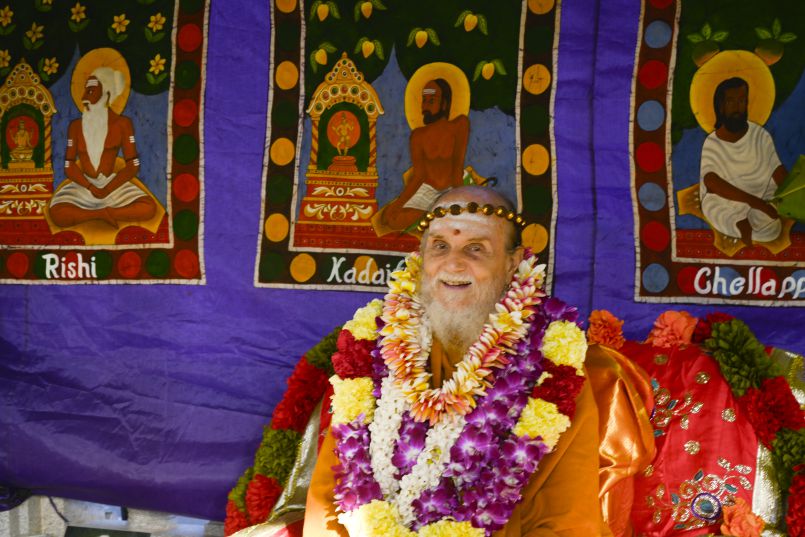
Jai Satguru Bodhinatha Veylanswami!
On July 19th we celebrated Guru Purnima at Iraivan Temple. While there was a live stream, we though it would still be nice to share some belated photos of the event.
"Upon the connection between Guru and shishya, the spirit of parampara travels, the spirit of sampradaya travels. It causes the words that are said to sink deep. They don't just bounce off the intellect, the message goes into the individual. Spiritual force doesn't just happen." - Gurudeva
Wooden Stand for Aquarium in Media Studio

Over the past two months, the Ganapati Kulam has been working on a cabinet that will support a 115-gallon display aquarium. The cabinet is made from Formosa Koa and patina copper. It is made from the exquisite wood originating from the same tree as the Cedar Room table, and displays the same beautiful, curly grain. The cabinet is joined together through the use of floating tenons, and has been built strong enough to withstand the 1000+ pound weight of the filled aquarium it will support.
The wood has been finished in a hand-rubbed style using six coats of polymerized tung oil and wax. The resulting surface of the wood is silky smooth and is almost as reflective as a mirror. A heavy bronze medallion will be affixed to the back side. We are excited to see it come together to completion in the next few weeks!
More Purnima Vows – Nirvani, Yogi and Samaya and Vishesha Dikshas
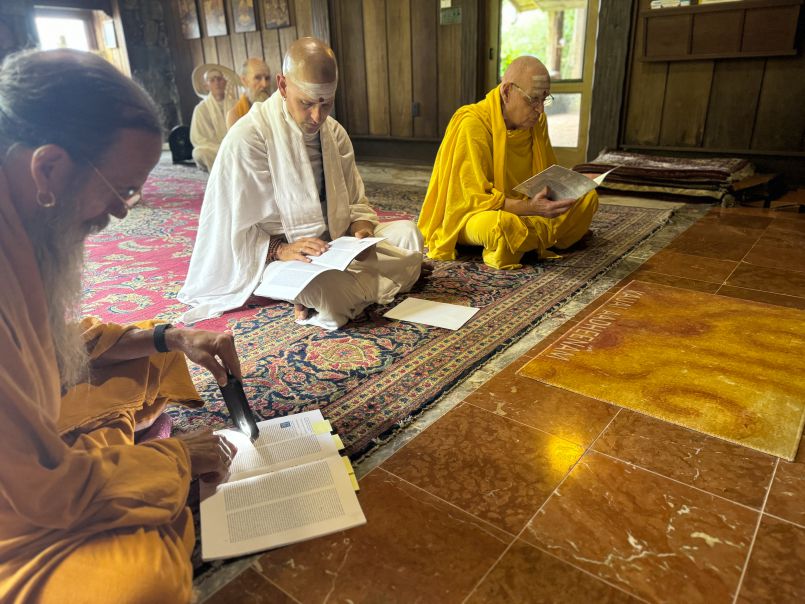
Jai Ganesha!
Vel Muruga!
Jai to the Kailasa Parampara!
Aum Namah Sivaya!
Following Guru Purnima, we had several other events. As seen in a previous post, our newest Sadhaka and Supplicant took vows. Also during this time, we had the formal vow renewals of Nirvani Tejadevanatha and Yogi Haranandinatha. Both of these exemplary monks were blessed by Satguru as they formally continue their lifetimes of discipline and inner striving.
Also, we're happy to announce that Vani Chenganna has received Samaya Diksha, an initiation to recite the panchakshara mantra "Aum Namah Shivaya." Just one year ago, Vani visited Kauai to take her Vrata Shishya vows.
Next, Vasanthakumari received Vishesha Diksha with many blessings from Satguru, Gurudeva and the Guru Parampara.
All in all, an enriching and wonderful few weeks, full of renewed and rewarding inner and outer dedications.
Aum Namah Sivaya. Sivaya Namah Aum.
Before & After and a Bit of History
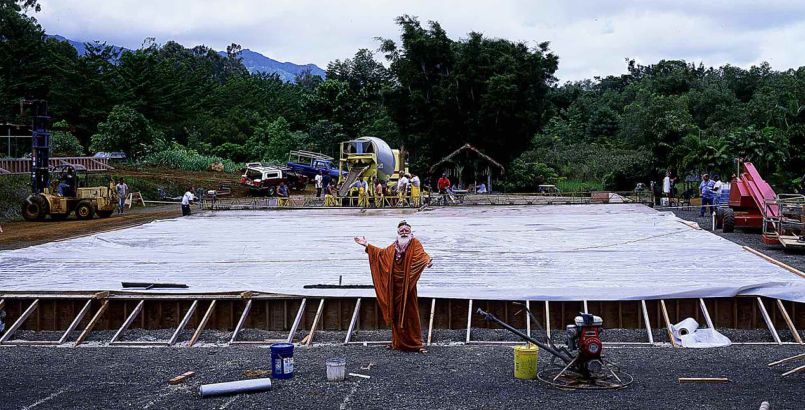


You are familiar with Iraivan's unique concrete foundation, which earned us a cover on Concrete Today magazine back in 1999. For those new to the story, after years of research and preparation, in August of 1999, the foundation of the Iraivan temple was poured.
At the time, the lead engineer exclaimed: "This hasn't happened for 2,000 years! It's historic. Not since the Greeks and Romans has such a massive placement of concrete been completed without a single crack. Not even a hairline fissure." Dr. Mehta's joy spread throughout Kauai's Hindu Monastery and the island.
The 117' 6" by 56' by 4' foundation weighs over 4 million pounds and took exactly 108 cement trucks to place. Founder and Satguru Sivaya Subramuniyaswami, who had declared it must last 1,000 years, now knew that it would.
This pioneering project was made of a special mix that reduces Portland cement by about 40% and replaces it with pozzolan coal fly ash. Dr. Mehta noted that this makes a superior concrete, stronger, more durable, harder, and even cheaper.
Its adoption by nations and industries could radically reduce the global warming problem, for which cement production worldwide is responsible for an astonishing 6%.
The temple could, in time, change how things are built on earth. And in fact, it did. This foundation inspired China to use it for their Olympic Games Stadium. And today, California requires government projects to use it in place of normal cement.
Wisdom’s Path, Part One
Satguru Bodhinatha Veylanswami gives his weekly upadesha in Kadavul Temple at Kauai’s Hindu Monastery in Hawaii. It is part of a series of talks elaborating on the inspired teachings of Satguru Śivaya Subramuniyaswami as found in his book Merging With Śiva.
"To the awakened mystic, there is only one mind. There is no “your mind” and “my mind,” just one mind, finished, complete in all stages of manifestation. Man’s individual awareness flows through the mind as the traveler treads the globe. Just as the free citizen moves from city to city and country to country, awareness moves through the multitude of forms in the mind."
A New Sadhaka & New Supplicant Take Vows
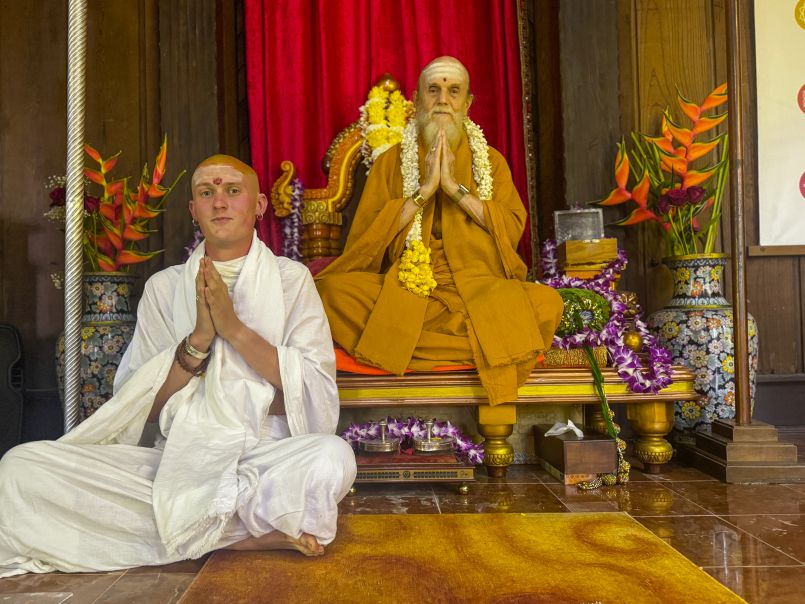
Jai Ganesha!
Vel Muruga!
Jai to the Kailasa Parampara!
Aum Namah Sivaya!
In the midday following the Guru Purnima abhishekam on July 19th, both Shankara and Kodiswara formally moved forward on the Great Path. Sadhaka Shankaranatha is our newest formal monastic, and Sivanadaiyar Kodiswara is our new supplicant--the final stage of training before taking vows as a mathavasi. Satguru and the monks gathered in the guru pitham to witness the event. First Shankaranatha read and signed his vows. He then received his monastic vestments, including his new silver earrings. Following his vows, Kodiswara entered to sit before Satguru and take his vows as a supplicant.
The following are excerpts from a Sadhaka's four vows:
THE SACRED VOW OF HUMILITY: known in Tamil as PANNIVU
Humility is the state of profound maturity in which the soul, immersed in the depths of understanding and compassion, radiates the qualities of mildness, modesty, reverent obeisance and unpretentiousness. There is an analogy in the Saivite tradition that compares the unfolding soul to wheat. When young and growing, the stalks of wheat stand tall and proud, but when mature their heads bend low under the weight of the grains they yield. Similarly, man is self-assertive, arrogant and vain only in the early stages of his spiritual growth. As he matures and yields the harvest of divine knowledge, he too bends his head. In the Tamil language this absence of pride or self-assertion is known as pannivu. Pannivu also means "jewel." In the Tirukural it is said that "Humility and pleasant words are the jewels that adorn a man; there are none other."
Humility does not consist in concealing our merits and virtues or in thinking ourselves worse or more ordinary than we are. Nor is it a pretended meekness. Rather it lies in not exalting ourselves before others for we perceive the grandeur of God Siva in every human being and reverently acknowledge Him there. Humility in this ideal is the awakened perception that "Siva is All." It is the inner being predominating over the outer nature.
THE SACRED VOW OF PURITY: known in Tamil as TIRIKARANNASUTTI
Purity is the pristine and natural state of the soul. It is not something which the monastic attains as much as that which he already is, and which becomes evident as the layers of adulterating experience and beclouding conceptions are dissipated. Purity is clarity and clearness in all dimensions of being. It is innocence as opposed to familiarity with the ways of the world. It is for monastics the observance of chastity, called brahmacharya. In Tamil purity is given its fullest expression in the term tirikarannasutti, which means "purity in mind, speech and body." These three--also called thought, word and deed--convey the fullness of the ideal of purity.
Purity does not consist in merely doing good and being good, though these are essential, nor is it an outward appearance or show of such goodness. It is primarily an inner quality, equally present in the saint who outwardly reflects the purity of his attainment and in the sage who inwardly rests in that same purity though his attainment may not be apparent. Purity is not a manner of behavior, though it may be reflected in our behavior, and there is no merit in taking on the appearance of being pure when one is not yet pure.
THE SACRED VOW OF OBEDIENCE: known in tamil as TAALVU ENUM TANMAI
Obedience is the state of willingness and cooperation in which the soul remains open and amenable to enlightened direction. For the monastic it is an unbroken pledge of trust in and surrender to the satguru, the guru parampara and the mystic process of spiritual evolution. In the Tamil language this definition of obedience is expressed in the term taalvu enum tanmai, which denotes "the quality or state of humble submission."
Obedience does not consist in blind submission and yielding to authority, nor in weakening our own will that it may be dominated by the will of another. Yet it is, in another sense, submission to a sacred purpose and the divine authority of the Second and Third Worlds. It is, for the monastic, an inner quality that allows him to remain consciously tractable and responsive. In the beginning, while the instinctive nature remains strong and there exists a sense of "I" and "mine," obedience is a surrendering of the ego to the soul or the instinctive nature to the spiritual nature. As long as the ego dominates the life of man, he will experience obedience as capitulation or subjection. As the soul unfolds and separateness is replaced by knowledge of the unity that pervades the universe, obedience is perceived as the union of minds and purpose, a state of harmony so complete that there can exist no distinction between him who gives and him who receives instruction or direction. True obedience is based on agreement, trust and knowledge, as opposed to passive servility, nonresistance or domination, which have ignorance and fear as their basis.
Confidence is the state of trust in which the sacred teachings and sensitive or personal matters are not divulged to others. Spiritual matters must be protected and preserved by those to whom they are entrusted, never wantonly or indiscriminately revealed. When we confide in another, we do so with the assurance that sensitive and serious information will not be inappropriately disclosed. In the Tamil language confidence is known as rahasiyam, meaning "secret or mystery."
Confidence as applied to these Sacred Vows does not mean "certainty," "a belief in one's abilities" or "self-confidence." Rather it is a confiding, a trusting and a relying upon. It is the controlled sharing of privileged teachings or information that should not be disclosed, but held in confidentiality. In its most simple form it is the keeping of a secret.
Confidence for the monastic may be defined as wisdom in handling information. The monastic must learn to hold in strict secrecy all spiritual direction and esoteric laws entrusted to him, never revealing them unless specifically ordained to do so. He must realize the wisdom of Saint Yogaswami's statement that "Sacred is secret and secret is sacred," never treating the inner teachings as ordinary knowledge to be published or spoken of to the public or prematurely disclosed to devotees.
Aum Namah Sivaya
New Chellappaswami Art
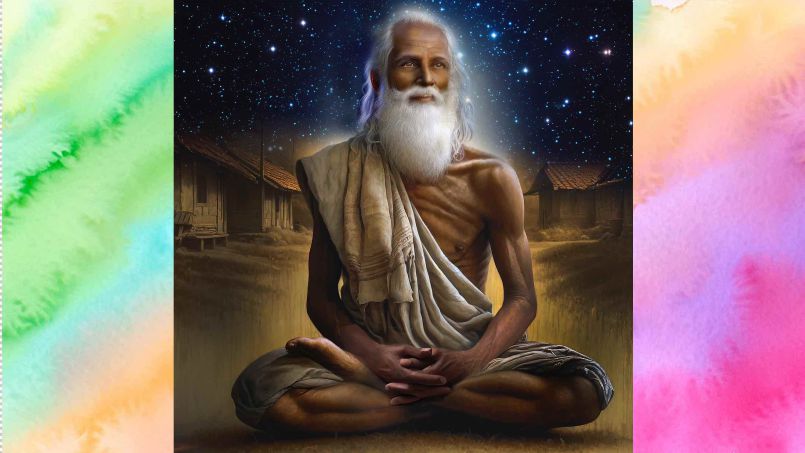
Chellappaswami was one of Sri Lanka's most respected 20th century gurus. He lived from 1840 to 1915 and was the guru of our Yogaswami and the shishya of Kadaitswami. Today we received this unusual artistic depiction of Chellappaswami from a devotee who loves the paramparai and without our knowing worked for many hours using AI and Photoshop to give a fresh rendering of the Great Sage. AI art is evolving quickly as you can see. But so is art in general. If you skip to the second slide, you will see the original art which formed the basis of this new one. This old art was produced by a devotee of Chellappaswami, Tiru Ponnambalan, and is really the only image of him we have from someone who knew him.
To read about the life of Chellappaswami as told in The Guru Chronicles, go here:
More about Chellappaswami
The Story of Awareness, Part Four
Satguru Bodhinatha Veylanswami gives his weekly upadesha in Kadavul Temple at Kauai’s Hindu Monastery in Hawaii. It is part of a series of talks elaborating on the inspired teachings of Satguru Śivaya Subramuniyaswami as found in his book Merging With Śiva.
"Consciousness and awareness are the same when awareness is totally identified with and attached to that which it is aware of. To separate the two is the artful practice of yoga. Naturally, the Shūm-Tyeīf language is needed to accomplish this. When awareness is detached from that which it is aware of, it flows freely in consciousness. A tree has consciousness. Awareness can flow into the tree and become aware of the consciousness of the tree. Consciousness and mind are totally equated as a one thing when awareness and consciousness are a one thing to the individual. But when awareness is detached from that which it is aware of, it can flow freely through all five states of mind and all areas of consciousness, such as plants and the Earth itself, elements and various other aspects of matter. Here we find awareness separate from consciousness and consciousness separate from the five states of mind attributed to the human being. In Sanskrit we have the word chaitanya for consciousness, and for awareness it is sākshin, meaning witness, and for mind the word is chitta. Consciousness, mind, matter and awareness experience a oneness in being for those who think that they are their physical body, who are convinced that when the body ends, they end and are no more."
Guru Purnima Live Stream
Join us on July 19th, 2024, for Kauai Aadheenam's observance of Guru Purnima. We start our celebrations at 6:00am (Kauai time) with a short parade to Iraivan Temple followed by a padapuja to Satguru Bodhinatha Veylanswami.
Guru Purnima is a sacred festival celebrated to honor and express gratitude to our spiritual teachers. Observed on the full moon day (Purnima) in the Vedic Sanskrit month of Ashadha (June-July), this auspicious occasion highlights the invaluable role of the Guru, who dispels darkness and ignorance, leading their disciples toward enlightenment and self-realization.
From the Kularnava Tantra:
"And Lord Siva said: There is One Real. Call it Siva. This Parabrahman is formless, stainless, one without a second, changeless, beyond the highest. This Mahesvara is all-knowing, all-doing, sovereign of all, self-luminous, without beginning or end. All embodied souls, jivas, all the born creatures, are portions of Me, like sparks of the fire. But human birth is the most important, for it is then that one becomes awake, aware of his state of bondage and the necessity of release. It is then that one is in a position to take steps for his liberation from bondage's hold.
Humans have a self-will and are not totally subject to the impulses and drives of nature as are other creatures. It is only on this earth--and that too in a human body endowed with a soul--that one can choose one's path for spiritual progress. But not all are aware of the precious opportunity afforded by human birth, which is truly the ladder to Liberation. The Self is to be realized only here in this life. If here you do not find it and work out the means for your Liberation, where else is it possible? It is possible nowhere else. It has to be worked out by yourself from within yourself.
The world you reach after the physical body is shed is determined by the level of consciousness reached while in the body. So, as long as the body lasts, exert yourself towards the goal of Liberation.
Remember, the physical body does not last forever. Age prowls like a leopard; diseases attack like an enemy. Death waits not to see what is done or not done. Before the limbs lose their vitality, before adversities crowd in upon you, take to the auspicious path.
Therefore, choose, then worship a Satguru. Worship his feet. Cherish the very sandals (paduka) which hold his feet. All knowledge is founded on those paduka. Remember and cherish those paduka, which yield infinitely more merit than any number of observances, gifts, sacrifices, pilgrimages, mantra-japa and rituals of worship."
Newest Hibiscus Planting
We are always needing more flowers to accomodate the growing needs related to running two temples and additional shrines.
In this case, the Siddhidata Kulam just planted a row of hibiscus to supply flowers for the Ganesha murti outside their new office and equipment maintenance building, along with other needs.
From Our Gurus' Teachings
Archives are now available through 2001. Light colored days have no posts. 1998-2001 coming later.

